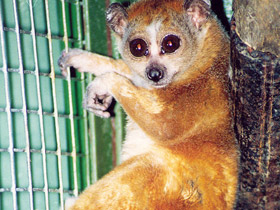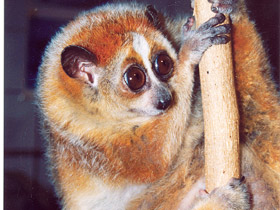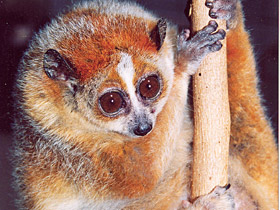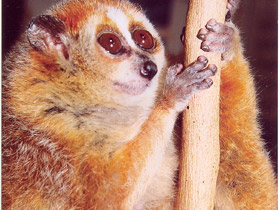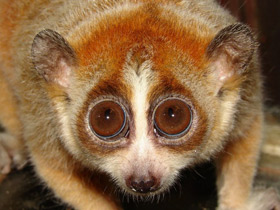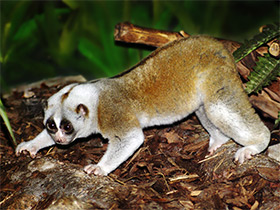The Sunda slow loris (Nycticebus coucang) or greater slow loris
The Sunda slow loris (Nycticebus coucang) or greater slow loris is a strepsirrhine primate and a species of slow loris native to Indonesia, West Malaysia, southern Thailand and Singapore.
Particularities and habitat area
Nycticebus coucang is a species of strepsirrhine primate of the family Lorisidae.
Nycticebus coucang is very similar to the parrot, but slightly larger: its body length is 26 to 38 cm (the parrot is 18 to 21 cm). These primates are found in Southeast Asia, and their range includes the jungles of the Malay Peninsula, Sumatra, Borneo and Java.
Taxonomy and phylogeny
The Sunda slow loris was first described (in part) in 1785 by the Dutch physician and naturalist Pieter Boddaert under the name Tardigradus coucang. However, its discovery dates to 1770, when the Dutchman Arnout Vosmaer (1720–1799) described a specimen of it as a type of sloth. Vosmaer gave it the French name "le paresseux pentadactyle du Bengale" ("the five-fingered sloth of Bengal"), but Boddaert later argued that it was more closely aligned with the lorises of Ceylon (now Sri Lanka) and Bengal.
Between 1800 and 1907, several other slow loris species were described, but in 1953 the primatologist William Charles Osman Hill, in his influential book, Primates: Comparative Anatomy and Taxonomy, consolidated all the slow lorises into a single species, Nycticebus coucang. In 1971 Colin Groves recognized the pygmy slow loris (Nycticebus pygmaeus) as a separate species, and divided Nycticebus coucang into four subspecies. In 2001 Groves opined that there were three species (Nycticebus coucang, Nycticebus pygmaeus, and Nycticebus bengalensis), and that N. coucang itself had three subspecies (Nycticebus coucang coucang, Nycticebus coucang menagensis, and Nycticebus coucang javanicus). These three subspecies were promoted in 2010 to species status—the Sunda slow loris, the Javan slow loris (N. javanicus) and Bornean slow loris (Nycticebus menagensis). Species differentiation was based largely on differences in morphology, such as size, fur color, and head markings. (At the end of 2012, the Bornean slow loris was itself divided into four distinct species.).
When Étienne Geoffroy Saint-Hilaire defined the genus Nycticebus in 1812, he made the Sunda slow loris the type species. This was questioned in 1921 by British zoologist Oldfield Thomas, who noted that there was some confusion over which specimen was used as the type specimen. Instead, he suggested that the type specimen was actually the Bengal slow loris, Lori bengalensis Lacépède, 1800. There was further confusion during the 1800s when Boddaert's Tardigradus coucang was routinely mistaken for Carl Linnaeus' Lemur tardigradus – a species he had described in the 10th edition of Systema Naturæ (1758) The fact that Lemur tardigradus was actually a slender loris remained obscured until 1902, when mammalogists Witmer Stone and James A. G. Rehn finally cleared the air.
The species has 50 chromosomes (2n=50), and it genome size is 3.58 pg. Of its chromosomes, 22 are metacentric, 26 are submetacentric, and none are acrocentric. Its X chromosome is submetacentric, and its Y chromosome is metacentric.
To help clarify species and subspecies boundaries, and to establish whether morphology-based classifications were consistent with evolutionary relationships, the phylogenetic relationships within the genus Nycticebus have been investigated using DNA sequences derived from the mitochondrial markers D-loop and cytochrome b. Although most of the recognized lineages of Nycticebus (including the pygmy slow loris (Nycticebus pygmaeus), Bornean slow loris (Nycticebus menagensis) and the Javan slow loris (Nycticebus javanicus)) were shown to be genetically distinct, the analysis suggested that DNA sequences from selected individuals of Sunda slow loris (Nycticebus coucang) and Bengal slow loris (Nycticebus bengalensis) shared a closer evolutionary relationship with each other than with other members of their own respective species. The authors suggest that this result may be explained by introgressive hybridization, as the tested individuals of these two taxa originated from a region of sympatry in southern Thailand; the precise origin of one of the Nycticebus coucang individuals was not known. This hypothesis was corroborated by a 2007 study that compared the variations in mitochondrial DNA sequences between Nycticebus bengalensis and Nycticebus coucang, and suggested that there has indeed been gene flow between the two species.
Reproduction
The biology of these two species is also similar, but the mother suckles her young for longer, up to 5 to 7 months, and the young reach sexual maturity later, at the age of 1.5 to 2 years. In captivity, Nycticebus coucang can live for a long time, more than 25 years.
Conservation
According to the 2020 International Union for Conservation of Nature (IUCN) Red List assessment, the Sunda slow loris was evaluated as endangered. In June 2007 it was transferred from CITES Appendix II to Appendix I, indicating a true concern about the state of international trade in this species, an act now forbidden by international law. It is also protected by Indonesian law, though the law does not seem to be strictly enforced. Its population size is unknown and further studies need to be carried out to confirm their conservation status.
The Sunda slow loris is greatly threatened by the pet trade, and is sold as an exotic pet throughout southeast Asia. The slow lorises are the most commonly traded protected primates in southeast Asia. When sold as a pet it often will have its teeth pulled out to prevent injury to the owner. This may cause dental infections which have up to a 90% death rate. Once it has lost its teeth, reintroduction to the wild is impossible. Due to a very high mortality rate in captivity due to stress, improper nutrition and infection, the pet trade is inflated by replacements. With a greater purchasing power, the increasing human populations in the species' range could have an even more serious impact.
The Sunda slow loris is further threatened by gathering for illegal traditional medicine. The fur is reported to heal wounds, the flesh to cure epilepsy, eyes are used in love potions, and the meat is reported to cure asthma and stomach problems. It is also killed as a crop pest. Severe habitat loss and degradation over large areas of its range have caused large population declines, even though the species is more adaptable to anthropogenic habitats than other primates in the region. The resulting fragmentation has restricted species dispersal as it depends on continuous canopy cover to move from tree to tree.

















